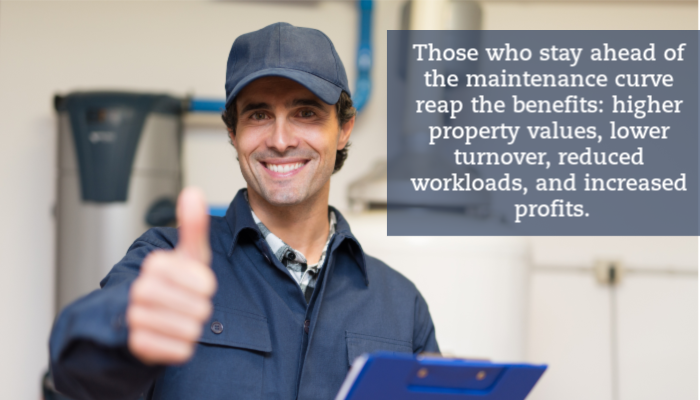The maintenance requirements of apartments and multi-family properties are very complex. From routine repairs for tenants and maintaining amenities to ensuring buildings are compliant with fire code, it can be challenging for property managers to stay on top of outstanding maintenance requests, let alone practice preventive maintenance.
That’s why the importance of an effective property maintenance plan cannot be overstated. A successful property maintenance strategy keeps tenants happy and insurance premiums under control. Today, we explore tips for handling maintenance requests quickly and efficiently—especially in light of the COVID-19 pandemic, which is creating an even greater challenge for property managers.
Understanding Your Property’s Maintenance Needs
When maintenance issues arise, tenants look for timely solutions. That’s why it is ideal to categorize your property’s maintenance needs ahead of time.
Establish an on-call maintenance team to take care of urgent and immediate maintenance tasks. Then, determine your plan for periodic maintenance, such as HVAC filter replacements, and seasonal maintenance, such as ice and snow removal. Finally, establish your preventive maintenance plan. Proactive measures help property managers to focus less on defense and more on offense. According to Buildings.com, “implementing a planned maintenance strategy rather than reactive can deliver major cost savings in the long term.”
The Importance of Preventive Maintenance
Preventive maintenance is both an art and a science. The duration of mechanical and structural life cycles is based on scientific data. At the same time, there’s an art to predicting when deterioration hints at looming problems in the future. Periodic walkthroughs are always important and can help property managers keep track of everything from cosmetic touch-ups to major system updates.
Those who stay ahead of the maintenance curve reap the benefits: higher property values, lower turnover, reduced workloads, and increased profits. Successful maintenance programs also build brands and enhance reputations, as tenants know their needs are being met.
Handling Maintenance Requests Quickly and Efficiently Through Property Management Software
Organizing your property’s maintenance needs is just one part of the solution. Property managers must also be able to track maintenance requests to ensure they’re handled in a timely manner and that no tenant request goes overlooked.
Property management software can be an essential tool to property managers, especially those who manage large, multi-family buildings. The right software saves time and money by helping property managers to follow maintenance work orders, set budgets, track expenses and even schedule preventive maintenance for the future. Likewise, tenants have a convenient way to communicate their requests and track the status of their requests online, which helps to improve resident satisfaction.
Yardi MultiFamily Suite, offered by Yardi Systems, is one example of a property management software that can track maintenance processes to ensure you are providing excellent service to your residents.
COVID-Era Property Maintenance
Building managers now face new challenges as they work to keep tenants, staff, vendors, and visitors safe. Learn from those on the front lines. For example, study what NYC building managers have done to keep high-density buildings clean and safe. In this new era, rely on experts and scientific data.
Monitor updates from the Centers for Disease Control (CDC), and watch for updates from local health departments. Be prepared to adjust your COVID-19 response as circumstances change. The CDC notes two ways the virus can spread. First, when respiratory droplets from sneezing or coughing reach another individual. Social distancing is a key strategy here. Second, when an individual touches a surface infected with the virus, and then touches their eyes, nose, or mouth. It’s possible to interrupt this path at several points by:
- Neutralizing the virus on surfaces that multiple individuals touch
- Repeatedly disinfecting the hands
- Keeping hands away from the face
This new reality redefines property maintenance. Managers, their teams, and their vendors should promote the following:
Disinfecting surfaces
Perform frequent, routine disinfection of surfaces touched by multiple individuals. This includes security desk areas, elevators, laundries, bathrooms and gyms. Hard surfaces are of particular concern, such as door knobs/handles, railings, light switches, counters, and tables are some examples. Close non-essential areas to better focus the cleaning where it’s most vital. The CDC provides detailed information about disinfecting surfaces. The EPA’s “List N” includes more than 350 chemicals approved for use as disinfectants.
Frequent hand sanitizing
Empower tenants, visitors, and workers to sanitize their hands wherever possible. Install hand sanitizer stations in high-traffic areas. Remind individuals of best practices by distributing multilingual educational materials about hand hygiene, social distancing, and coughing/sneezing etiquette. Post signs in lobbies, bathrooms, and other common areas. When necessary, rearrange work spaces and common areas to maintain social distancing.
Coming Together
During times like these, a shared humanity blurs the lines between tenants, management, visitors, maintenance staff, and delivery personnel. Now, more than ever, we are all in this together.
A calm, steady demeanor is important in times of uncertainty. As a property manager, maintain open lines of communication to share facts and reduce speculation and remain steadfast in enforcing policies designed to protect tenants and team members alike.
Assign team members to watch for new information about the virus. This might include news about local community spread, medical research, and scientific data. As emerging studies add to the understanding of the virus, your protocols can be fine-tuned.
Finally, in this new era, tenant feedback is more important than ever. Take advantage of property management software that automates parts of the feedback process and continue to monitor the level of resident satisfaction in your building.
Building Your Own Property Maintenance Strategy
It’s challenging for property managers to stay ahead of maintenance needs, especially during the COVID-19 outbreak. But by focusing your property maintenance strategy on a solid foundation of well-trained professionals, the right software, and consistent tenant feedback, you will be well on your way to building an efficient property maintenance plan.
Draper and Kramer uses Yardi property management software to ensure maintenance requests are handled in a timely and efficient manner, and tenants are encouraged to submit tickets for repairs and maintenance requests via the Yardi portal. To learn more about Draper and Kramer’s portfolio of luxury properties, please visit draperandkramer.com.

Focusing your property maintenance strategy on a solid foundation of well-trained professionals, the right software, and consistent tenant feedback, you will be well on your way to building an efficient property maintenance plan.